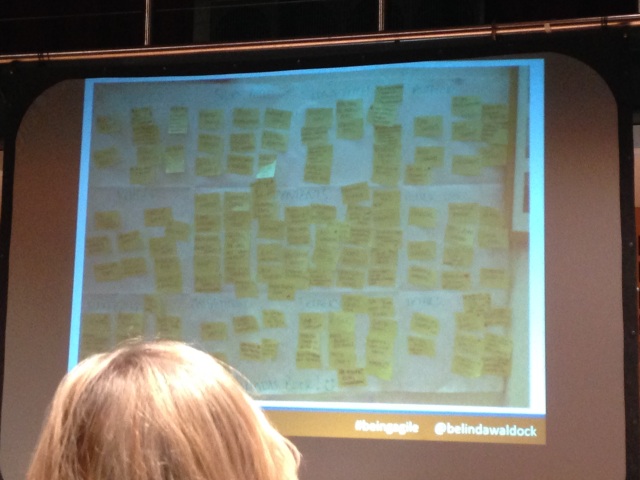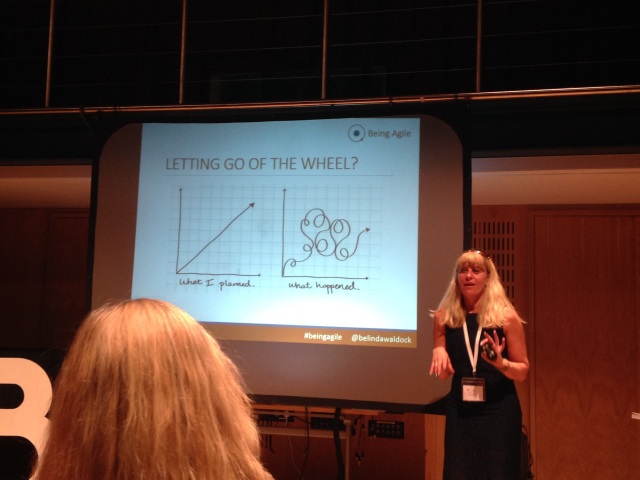What is Agile?
It’s a thinking, an approach a shift in culture. It is much more than processes and tools.
When Agile On The Beach first started it had a lot of help from European funding, around 80%. Last year was the first year that it was 100% privately funded, which is a great achievement.
Think about trying to apply the Pareto principle
20% effort creates 80% value. This means that you should focus on key channels. Agile addresses the pain point but will not deliver a perfect system first time. What it will allow you to do is to get something out earlier allowing you to collect feedback. This means that you end up with a better product in the long run that customers have influenced the direction of the final product.
This is a slightly different shift in how you think. Need to ask yourself where is the value?
Belinda actually does a demand driven approach when it comes to organising training sessions, she sells the tickets first and when there are enough people she will then book the trainer.
Belinda works with companies in Cornwall, she knows that there is a skills gap and works to fix the pipeline? She helps attract talent to businesses in Cornwall and actually if there are items of work to bid on, the businesses bid together as a unit as each business may have it’s own specialty but it is better to work together to bring business in than to compete against each other. Belinda believes that “We are stronger together”
From working with different people, this gave her enough ideas and collateral to write about how she has helped businesses in Cornwall creating a book, being Agile in Business. Her blog captures in more details how she created this book but this was done in an agile way.

The first proposal of book was the sections and then the post it notes for potential contents of each section. She worked with her editor adapting the publishing process. She knows that if she had tried to write a book in the traditional way, spending six months writing, then this being reviewed and needing to be changed then things wouldn’t have worked and no book would have been created. It only took 16 weeks to write and publish the whole book!

The book only needed 40000 words so Belinda could prioritise the post it notes in each section so not all contents made it. Writing her book in this way was an experiment to see if agile could be used in a more traditional environment. There was an interesting side effect of this experiment as the publishers liked this way of working and are still using it so Belinda writing her book helped this publishing team become more agile. The reason they liked it was due to the fact that they were given bit size chucks of text to review more often. These regular interactions actually decreased the amount of changes needed as Belinda and the Editor got more used to each other and what was required. This prevented any mass changes needing to be done.
The Agile Manifesto talks about interactions over processes. When Belinda works with teams she often uses the ship retrospective. This is looking at what makes you run faster, which is the wind in the sails but what is holding you back, the anchor. Then the team has to rack the post it notes from -10 to +10 (the – is holding you back, the + is making you go faster) per person. This allows the team to see what the key things are and from this, then create the actions. This allows time to look back on the last iteration and gives an opportunity for the team to feedback to others how they are feeling.
When Belinda works with businesses she tells them that 80% of their time should be spent running the business and 20% of their time should be spent improving the business. She is a big believer of visualising your work, be proud of what you do and encourages people to use Kanban boards, whether you are a team or just working alone. These boards are used to prioritise the ideas and indirectly will help people to work together, showing everyone what items people are working on. By using boards this can help people to work as a team a bit more as they are discussing their work together and hopefully coming up with solutions as a team. One of the ways she knows that she has helped a business is when she sees things that she has suggested being used in a new way. One company was using the sailing boat to visualise whether the company should move into a new area of working, highlighting the things that could be good and the things that were holding them back from expanding.
Belinda worked with a company called Glitterarty. They create hairbands and things to help you style your hair. One of their loyal customers requested a monthly box to be sent to them, a box of goodies each month. This also allowed the company to get rid of bits of odd stock but was a lovely treat for the subscribers. This monthly box actually created a community of people by utilising social media. This allowed the company to build a product and adapt it. Then the regular subscribers provided enough steady funds that allowed the company to scale. You need to have a plan but accept that the plan will change. You will not stay on course but there does need to be an original plan. To keep existing there needs to be a response to change.

The Kanban board is very valuable and you should listen to the board, paying attention to what it’s telling you. If you need to change the board take a step back and ask why. Normally it is a change to process that is required rather than a change the board. The benefit of Agile is that it shows you the problems and then you can use this information to fix the problems. This allows people to focus on their real job which in turn makes them happier. The increased visibility provides an environment for people to communicate better.
The change Belinda would do to the Agile Manifesto is to change it to working solutions rather than working software as software is not always what is required.



Pingback: Agile on the Beach : Being Agile in Business